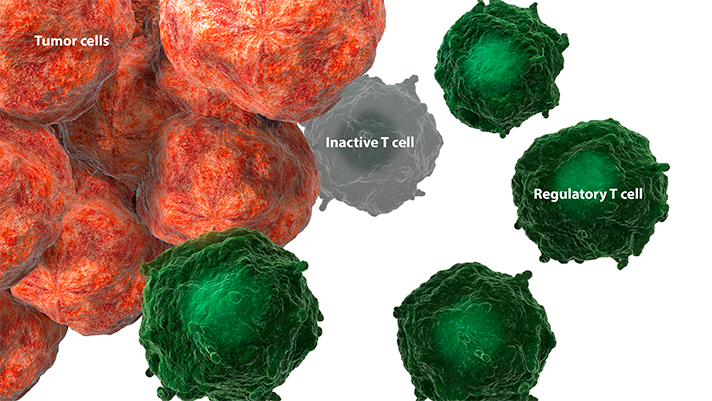Immune Suppression Markers
Cells and proteins within the tumor and its microenvironment can suppress T-cell activation, promote T-cell exhaustion, or activate regulatory T cells (Tregs)1,2. Several exploratory I-O biomarkers are associated with inhibition of the antitumor immune response.
Regulatory T cells (Tregs)
Regulatory T cells (Tregs) or suppressor cells, suppress the immune response by modulating the activation of effector T cells.1,2 Tregs are important in maintaining self-tolerance and preventing autoimmunity.1 The increased infiltration of Tregs into the tumor microenvironment has been observed in a variety of tumor types.3 The presence and activity of Tregs in tumor tissue and blood can be evaluated by cell-sorting technology such as flow cytometry.4
Tregs are under investigation as a potential I-O biomarker.


Lymphocyte-activation gene 3 (LAG-3)


Lymphocyte-activation gene 3 (LAG-3) is an immune checkpoint receptor expressed on activated cytotoxic T cells and Tregs.1,2 Increased LAG-3 expression on cytotoxic T cells can directly promote T-cell exhaustion. Increased expression on Tregs can indirectly suppress cytotoxic T-cell function. This dual function of LAG-3 can promote tumor immune evasion.1,3-5 In several cancers,
LAG-3 is under investigation as a potential
Myeloid-derived suppressor cells (MDSCs)
Myeloid-derived suppressor cells (MDSCs) are recruited to the tumor microenvironment to suppress effector cell responses through mechanisms including the promotion of T-cell exhaustion and dysfunction.1,2 Increased presence of MDSCs in the tumor microenvironment has been observed in a variety of solid tumors.2 The presence of MDSCs in tumor tissue and blood can be evaluated by cell-sorting technology such as flow cytometry.3
MDSCs are under investigation as a potential I-O biomarker.


Indoleamine-2,3-dioxygenase-1 (IDO)


Indoleamine-2,3-dioxygenase-1 (IDO) is an intracellular enzyme that initiates the breakdown of tryptophan into kynurenine in the tumor microenvironment to suppress immune responses.1-3 Tryptophan is an amino acid essential for the survival of cells, including cytotoxic T cells.4,5 Tumor cells can upregulate IDO expression and activity in order to improve their survival.6 Increased IDO expression has been associated with decreased T-cell infiltration and function, as well as increased development of immunosuppressive Tregs.7,8 Upregulation of IDO has been observed in several tumor types.8 The presence or activity of IDO is most commonly measured using IHC, PCR, or changes in serum kynurenine.8,9
REFERENCES: Immune Suppression Markers
1. Lindau D, Gielen P, Kroesen M, Wesseling P, Adema GJ. The immunosuppressive tumour network: myeloid-derived suppressor cells, regulatory T cells and natural killer T cells. Immunology. 2013;138(2):105-115. 2. Matsuzaki J, Gnjatic S, Mhawech-Fauceglia P, et al. Tumor-infiltrating NY-ESO-1-specific CD8+ T cells are negatively regulated by LAG-3 and PD-1 in human ovarian cancer. Proc Natl Acad Sci U S A. 2010;107(17):7875-7880.
REFERENCES: Regulatory T cells
1. Pardoll DM. The blockade of immune checkpoints in cancer immunotherapy. Nat Rev Cancer. 2012;12(4):252-264. 2. Melero I, Berman DM, Aznar MA, Korman AJ, Pérez Gracia JL, Haanen J. Evolving synergistic combinations of targeted immunotherapies to combat cancer. Nat Rev Cancer. 2015;15(8):457-472. 3. Nishikawa H, Sakaguchi S. Regulatory T cells in cancer immunotherapy. Curr Opin Immunol. 2014;27:1-7. 4. Santegoets SJ, Dijkgraaf EM, Battaglia A, et al. Monitoring regulatory T cells in clinical samples: consensus on an essential marker set and gating strategy for regulatory T cell analysis by flow cytometry. Cancer Immunol Immunother. 2015;64(10):1271-1286.
REFERENCES: LAG-3
1. Huang CT, Workman CJ, Flies D, et al. Role of LAG-3 in regulatory T cells. Immunity. 2004;21(4):503-513. 2. Baixeras E, Huard B, Miossec C, et al. Characterization of the lymphocyte activation gene 3–encoded protein: a new ligand for human leukocyte antigen class II antigens. J Exp Med. 1992;176(2):327-337. 3. Goding SR, Wilson KA, Xie Y, et al. Restoring immune function of tumor-specific CD4+ T cells during recurrence of melanoma. J Immunol. 2013;190(9):4899-4909. 4. Blackburn SD, Shin H, Haining WN, et al. Coregulation of CD8+ T cell exhaustion by multiple inhibitory receptors during chronic viral infection. Nat Immunol. 2009;10(1): 29-37. 5. Camisaschi C, Casati C, Rini F, et al. Cutting-edge: LAG-3 expression defines a subset of CD4+ CD25high Foxp3+ regulatory T cells that are expanded at tumor sites. J Immunol. 2010;184(11):6545-6551. 6. Vilgelm AE, Johnson DB, Richmond A. Combinatorial approach to cancer immunotherapy: strength in numbers. J Leukoc Biol. 2016;100(2):275-290. 7. Bottai G, Raschioni C, Losurdo A, et al. An immune stratification reveals a subset of PD-1/LAG-3 double-positive triple-negative breast cancers. Breast Cancer Res. 2016;18(1):121.
REFERENCES: MDSCs
1. Joyce JA, Pollard JW. Microenvironmental regulation of metastasis. Nat Rev Cancer. 2009;9(4):239-252. 2. Kumar V, Patel S, Tcyganov E, Gabrilovich DI. The nature of myeloid-derived suppressor cells in the tumor microenvironment. Trends Immunol. 2016;37(3):208-220. 3. Vasquez-Dunddel D, Pan F, Zeng Q, et al. STAT3 regulates arginase-I in myeloid-derived suppressor cells from cancer patients. J Clin Invest. 2013;123(4):1580-1589.
REFERENCES: IDO
1. Mellor AL, Munn DH. Tryptophan catabolism and T-cell tolerance: immunosuppression by starvation? Immunol Today. 1999;20(10):469-473. 2. Munn DH, Shafizadeh E, Attwood JT, Bondarev I, Pashine A, Mellor AL. Inhibition of T cell proliferation by macrophage tryptophan catabolism. J Exp Med. 1999;189(9): 1363-1372. 3. Munn DH, Sharma MD, Lee JR, et al. Potential regulatory function of human dendritic cells expressing indoleamine 2,3-dioxygenase. Science. 2002;297(5588):1867-1870. 4. Lee GK, Park HJ, Macleod M, et al. Tryptophan deprivation sensitizes activated T cells to apoptosis prior to cell division. Immunology. 2002;107(4):452-460. 5. Mellor AL, Munn DH. IDO expression by dendritic cells: tolerance and tryptophan catabolism. Nat Rev Immunol. 2004;4(10):762-774. 6. Liu P, Xie BL, Cai SH, et al. Expression of indoleamine 2,3-dioxygenase in nasopharyngeal carcinoma impairs the cytolytic function of peripheral blood lymphocytes. BMC Cancer. 2009;9:416. 7. Brandacher G, Perathoner A, Ladurner R, et al. Prognostic value of indoleamine 2,3-dioxygenase expression in colorectal cancer: effect on tumor-infiltrating T cells. Clin Cancer Res. 2006;12(4):1144-1151. 8. Holmgaard RB, Zamarin D, Li Y, et al. Tumor-expressed IDO recruits and activates MDSCs in a Treg-dependent manner. Cell Rep. 2015;13(2):412-424. 9. Spranger S, Spaapen RM, Zha Y, et al. Up-regulation of PD-L1, IDO, and Tregs in the melanoma tumor microenvironment is driven by CD8+ T cells. Sci Transl Med. 2013. doi:10.1126/scitranslmed.
3006504.

